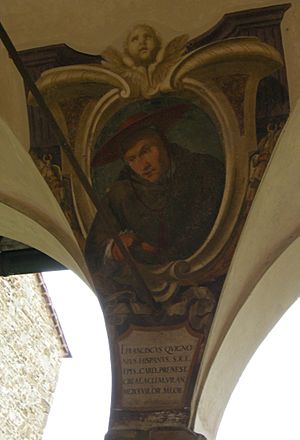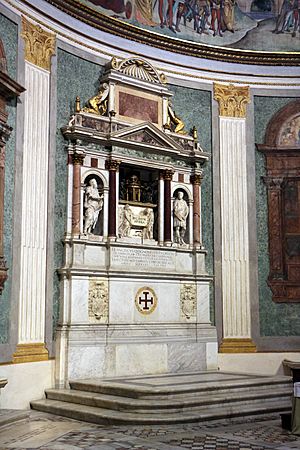Francisco de Quiñones facts for kids

Francisco de Quiñones (born around 1482 in Kingdom of León, Spain – died November 5, 1540, in Veroli, Papal States) was an important Spanish Franciscan friar. A friar is like a monk who lives in the community and helps people. He later became a cardinal, which is a high-ranking official in the Catholic Church, just below the Pope. Francisco de Quiñones helped bring about some important changes and improvements in the Catholic Church in Spain. He was also known as Francisco de los Ángeles.
Contents
Early Life and Becoming a Friar
Francisco de Quiñones was the son of Diego Fernandez de Quiñones, who was a Count. When he was young, he was educated by Cardinal Ximenes, another very important church leader.
At 16 years old, Francisco joined the Order of Friars Minor in 1498. This was at a place called St. Mary of the Angels in Alcalá de Henares. When he joined, he took a new religious name: Francis of the Angels.
After finishing his studies, he took on many important jobs within the Franciscan Order. He became a leader in different parts of the Order, like a Custos, Commissary General, and Vicar General. These roles meant he was in charge of different groups of friars.
In 1521, he even got special permission from Pope Leo X to go on missions to the Americas. He planned to go with another friar named Jean Glapion, who was a close advisor to Emperor Charles V. However, Glapion died that same year.
Leading the Franciscans
From 1523 to 1527, Francisco de Quiñones was elected the Minister General of the Franciscan Order. This meant he was the main leader of all Franciscans.
As Minister General, he traveled a lot to visit Franciscan friaries. He visited places in Spain, Italy, and the Spanish Netherlands. He worked hard to make sure friars were well-educated and followed the rules of their Order. He also strongly supported sending missionaries to new lands. For example, in 1524, he sent twelve missionaries to Mexico. One of them, Friar Juan Juárez, later became the first bishop in what is now the United States.
After the city of Rome was attacked in 1527, Pope Clement VII was taken prisoner. Francisco de Quiñones was related to Emperor Charles V and was also trusted by him. Because of this, he was seen as the best person to help free the Pope and make peace between the Pope and the Emperor. Quiñones traveled to the Emperor three times to help. His efforts worked, and Pope Clement was freed in December 1527. This also led to important peace agreements, like the Treaties of Barcelona (1528) and Cambrai (1529).
Becoming a Cardinal
Because his work helping the Pope and Emperor was so demanding, Quiñones could not properly lead the Franciscan Order anymore. So, in December 1527, he stepped down from his role as Minister General.
In September 1528, he was made a cardinal. He was given the title of S. Croce in Gerusalemme, which is why he was sometimes called "Cardinal of the Holy Cross." From 1530 to 1533, he was also a Bishop in Spain. For a short time in 1539, he helped manage a diocese (a church district) near Naples in Italy.
As a cardinal, Quiñones was always an important figure in the Sacred College, which is the group of all cardinals. He paid close attention to the Reformation movement happening in Germany. The Reformation was a big change in Christianity that led to new Protestant churches.
When Pope Paul III thought about holding a big meeting called a general Council in 1536, he sent Quiñones to Emperor Ferdinand I to promote the idea. Sadly, Quiñones died in 1540 and did not live to see the start of the Council of Trent in 1545, which was a very important meeting for the Catholic Church. His body was brought from Veroli to Rome and buried in his church, Santa Croce in Gerusalemme.
Changes to Church Prayers
Francisco de Quiñones is most famous for trying to change the Roman Breviary. The Breviary is a book of prayers and readings used by priests and religious people every day. He started this work in 1535, following orders from Pope Clement. Pope Paul III then released his new version that same year. A second updated version came out in 1536.
This new Breviary was mainly meant for private use. But with permission, many religious houses started using it. Over 100 different versions were printed between 1536 and 1566. However, some people criticized it because it changed too many old traditions. Because of this, Pope Paul IV banned its use in 1558.
See also
 In Spanish: Francisco de los Ángeles Quiñones para niños
In Spanish: Francisco de los Ángeles Quiñones para niños


